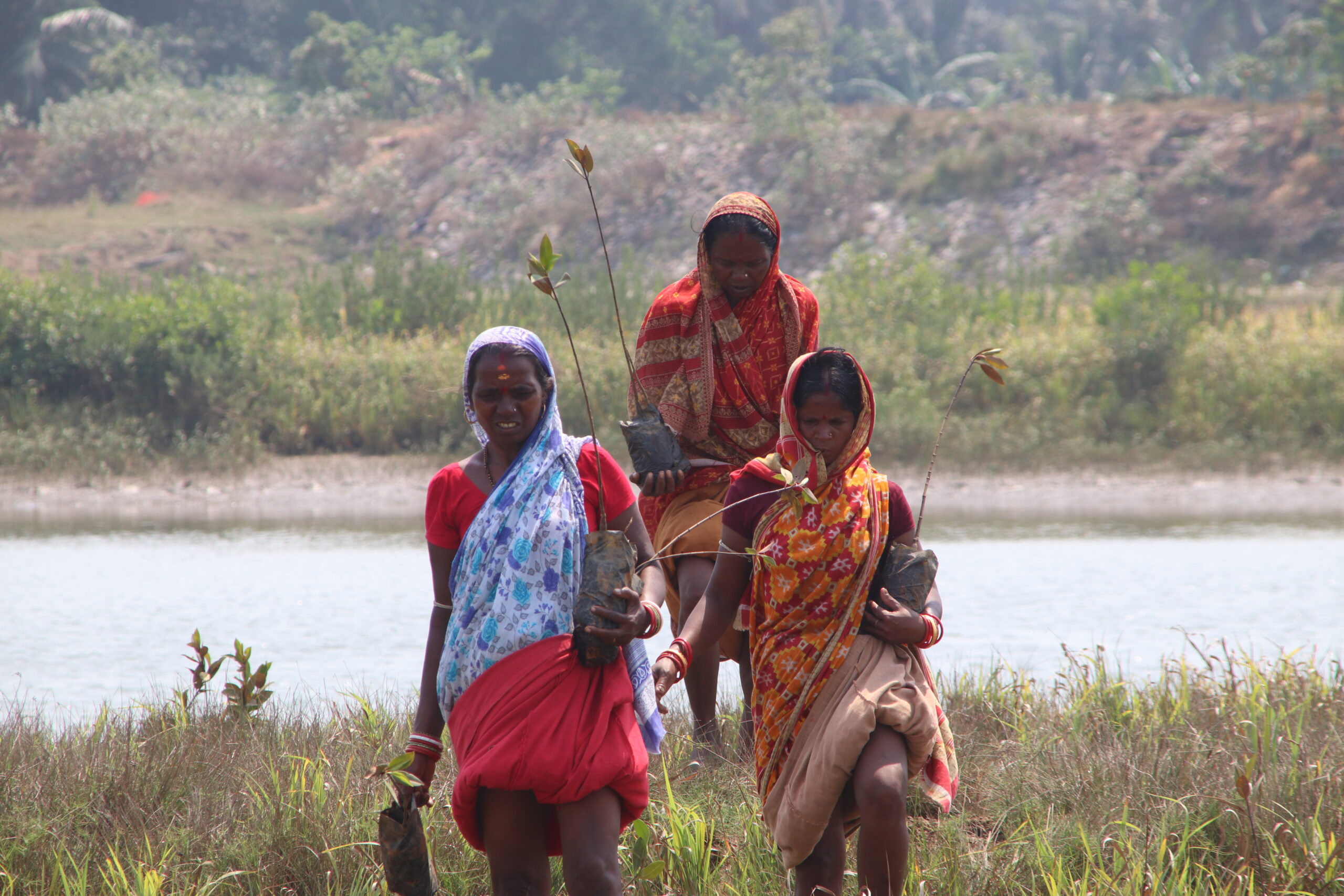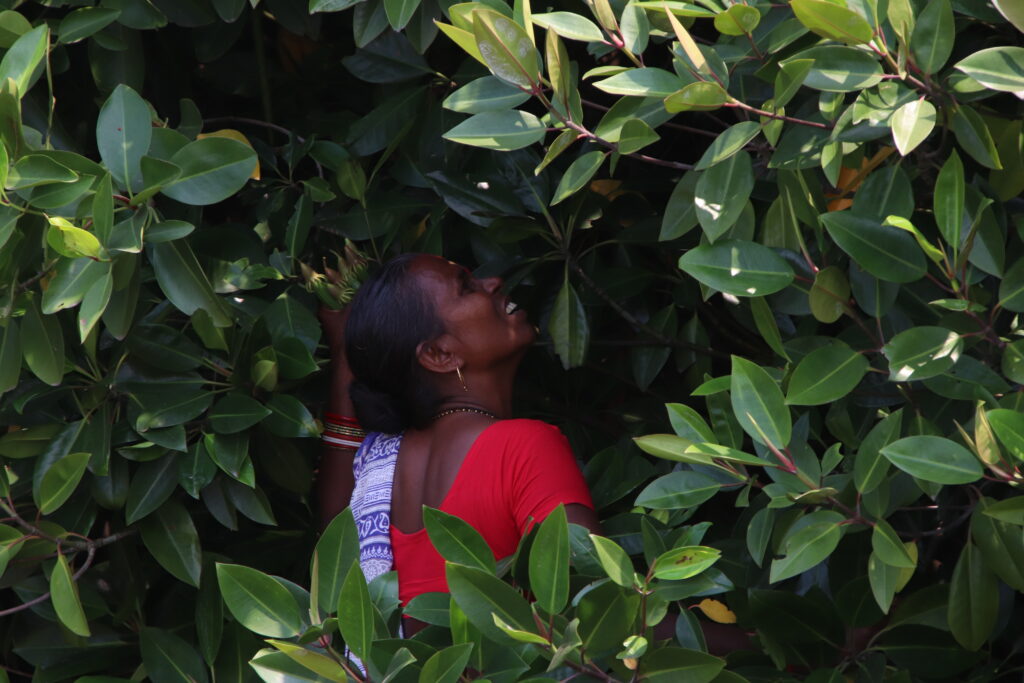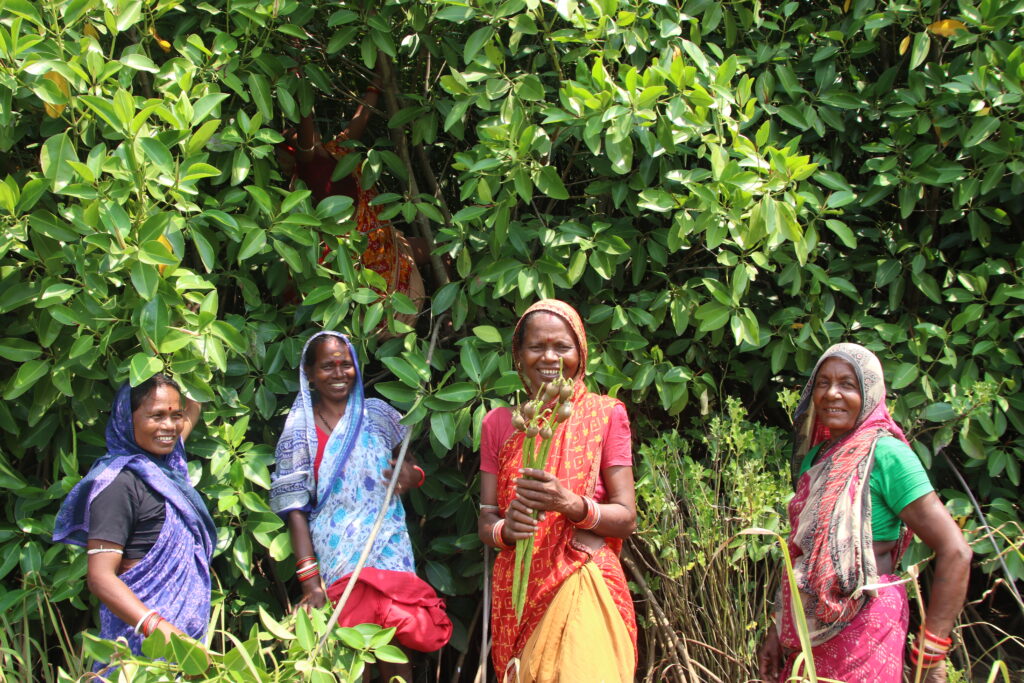Women Who Guard The Tides: Mangrove Conservation In The Absence Of Land Rights
When men migrate for work, it is the women who work to conserve the mangroves of disaster-prone coastal Odisha to protect the fragile ecosystem from erosion. But they have no rights over these mangrove lands

It is still dark when Nalini Kandi, 48, rises. It will be a while before the world around her starts stirring, but by 4 am, she has begun sweeping the mud-plastered floor of her small home. She then lights the wood stove, cooks rice and potato curry for her family, and packs a small meal for herself. By the time the first light seeps into the sky, she is ready to leave.
Nalini, a fisherwoman from Sana Jhadling village in Puri’s Astaranga block, belongs to the Dalit community, and this factor has shaped much of her life—where she can go, what work she can do, and how she is treated. But out in the ‘luni (mangrove) jungle’, she answers to no one except the tides and the land she has vowed to protect.
A short boat ride across the backwaters brings her closer to the swamp, but she is still far from her destination. The next stretch is a 30-minute walk through uneven terrain, sometimes through knee-deep water, sometimes over sharp, dry roots that threaten to pierce her bare feet.
Reaching the plantation, she tucks the loose end of her saree around her waist, folds it upwards like a lungi, and steps into the thick, sucking mud. Here, she begins her work, wading knee-deep through the swamp, scanning the fragile saplings for any damage. Each broken stem and each uprooted plant tells a story of struggle—battered by tides, gnawed by crabs, or uprooted by those who see no value in these tangled forests. She carefully plucks the now mature propagules (mangrove seeds) hanging from the mangrove trees.

Retracing her steps, she stops near the water’s edge, pushing the propagules into the mud with steady hands, securing them in place before the tides return. She then walks to the nursery of the mangroves and weeds out any unwanted growth, ensuring that nothing hinders their survival.
Her work is meticulous, methodical. It is a battle fought every week against erosion, climate change, and indifference. The mangroves do not yield easily, but neither does she.
With her task complete, Nalini washes the mud from her arms, retrieves her slippers, and begins the long journey home. The sun is higher now, the air heavier. By the time she steps onto her boat, she is exhausted, her feet sore, her body aching. Tomorrow, she will be out at sea, fishing—another fight, another way to sustain her family.
But on Wednesdays and Saturdays, she belongs to the mangroves.

Why Restore Mangroves
Sana Jhadling is home to 60 households, most of whom belong to Dalit communities. The village still remembers the devastation of the 1999 super cyclone, which wrecked their homes and devastated the entire state of Odisha. Since then, the state has experienced multiple natural calamities, with the frequencies of these cyclones increasing every year.
As the state grapples with repeated cyclones and natural disasters, its coastline grows increasingly vulnerable. In response, multiple state-led initiatives like mangrove and shelterbelt plantations, geo-tube installations, and strengthening of existing embankments have been launched to mitigate these devastating impacts. Among them are projects aimed at restoring lost mangroves, safeguarding existing ones, and even creating new mangrove forests.
These forests serve as a natural barrier to protect the coastal ecosystems. Their dense root systems absorb the force of strong winds and tidal surges, stabilising shorelines and preventing soil erosion. Additionally, they help limit seawater intrusion onto land. Studies indicate that regions with healthy mangrove cover suffer significantly less damage during cyclones than those lacking this crucial ecosystem which also supports fisheries, and provides fuel and construction materials. The ecosystem sustains the livelihoods of over 120 million people in coastal communities worldwide.
Over the years, scientists worldwide have sounded the alarm on the rapid loss of mangrove forests. Between 1980 and 2000 alone, an estimated 35% of global mangroves disappeared—a trend that continues today.
Odisha in particular, has 259.06 sq. km of mangrove forest cover, which is 5.19% of the country’s mangrove cover as of 2023 (full dataset on Dataful here). The state stands 6th in mangrove forest cover in India; Kendrapara district houses a major share of 209 sq. km (81%) of the state’s mangrove forests, while Puri has just 1.13 sq. km.
As the district continues to be one of the most vulnerable districts of the state to coastal natural calamities, mangrove restoration and development becomes a major mitigation factor.
However, the effort in Sana Jhadling was short-lived, the villagers allege. “They brought people from outside to plant mangroves, but they left once the job was done. How can an outsider care more about our ecosystem than we do?” asks Mamina Kandi (40), another villager and member of the conservation group.
Women’s Work
Most men in the village migrate for work, to bigger cities within Odisha or to other states like Tamil Nadu, Karnataka, Andhra Pradesh and Kerala. The efforts to cater to their families and conserve the local ecology falls on the women, who stay back in the village.
Two years ago, the women began conserving the existing mangroves and nurturing a nursery to scale up reforestation efforts. Soumya Biswal, a climate change advocate from the region, educated and engaged them in the initiative. The women in a group of four take turns visiting the mangrove plantation site to contribute to the conservation efforts.
“We have seen disasters up close—no roof over our heads, nowhere to go, destruction all around. And we have noticed how cyclones are becoming more frequent. We do not want our next generation to suffer the same fate. These mangroves are not for us but for them,” Mamina says.
The women are now educating women from other nearby villages to take up the conservation task to protect a larger coastline.
‘Only Footprints, No Ownership’
“Whose land is it? We do not know. We have no land, even in our village. We leave our footprints on the swamp every time we walk through it, but the land doesn’t belong to us,” Nalini says. “Without legal ownership, we have no say in decisions about these forests. If authorities decide to clear or commercialise them, we lose not just our livelihood but also our natural protection from cyclones and rising seas. But we will never give our luni jungle away.”

Though the mangroves are classified as jungles, there are no rights over the forests for the communities managing them. Because mangroves exist at the intersection of land and water, the legal framework governing them is often fragmented. Dedicated legislation for mangrove management is rare; instead, they are typically regulated under forest, fisheries, or wetlands laws, or through other legal tools focused on specific areas.
But over the years, experts have been arguing that just as territorial land rights exist, vulnerable coastal communities should also be granted rights over their ecosystems and to bring mangroves under the Forest Rights Act (FRA) of 2006 that grants community and individual rights over forest land.
There is no separate category called a ‘mangrove area’; by definition under the FRA, any land with a concentrated growth of trees, including mangroves, qualifies as a forest. The Supreme Court has already upheld this interpretation, reinforcing that mangrove forests fall under the purview of the FRA’s provisions for community and individual forest rights,” says Y Giri Rao, an expert on Forest Rights Act from Odisha. “The amount of community effort that is going into conserving these ecosystems is often ignored in the absence of legal rights over the land. Strengthening such legal recognition, would empower local conservation efforts and ensure long-term resilience against climate change.”
This legal ambiguity leaves coastal communities vulnerable, preventing them from securing formal rights to manage and benefit from the lands they are restoring.
The conservation efforts also add a little to their economic upliftment. For their mangrove conservation work, the women receive a modest honorarium of Rs 1,000 per month from Odisha Paryavaran Sanrakshan Abhiyan (OPSA). The village also has a Self-Help Group (SHG), but its role is limited to providing loans rather than generating additional livelihood opportunities. Even under MGNREGA, many women, despite holding job cards, have found little to no work in the village.
Waters Are Yielding Less
For generations, fishing has been the primary livelihood in Sana Jhadling, a responsibility largely shouldered by women. But the waters that once provided in abundance are also now yielding less.
“Earlier, two hours of fishing would give us enough to sell and consume. Now, even after spending twice the time, we barely catch half of what we used to,” says Nalini. If the catch is less than a kilogram, they no longer sell it but keep it for their own meals. The villagers list the local names of several fish species that have disappeared from their waters —“Khanga, Dahanga, Potei…”
A few families own small plots of land—less than an acre—where they cultivate paddy for their own consumption. “There is never enough to sell, only enough to eat,” they say.
But these lands, too, are owned by the men. The women believe that this land isn’t theirs to own. “We are fisherwomen. We belong to the water. But even the water isn’t ours, right?” Mamina asks.
Mamina has a piece of land that measures much less than one-fourth of an acre; it had belonged to her husband’s grandfather. By the time her husband inherited it there was hardly any land left. “How do I claim ownership of that? And who would give me that ownership?” she asks.
Even within their own families, women remain marginalised when it comes to land ownership. Across India, customary practices often exclude women from inheriting or owning land. In many cases, land titles are passed from father to son, leaving women economically dependent and legally powerless.
Navigating their lives between land and water, these women have little incentive to continue their work, which they believe is for the future generations and not for them.
Around 20 km from here in Gundalba village, a similar story unfolds. Women for generations have been protecting the mangrove and casuarina forests, winning national and international accolades for their conservation work but they still have to fight for legal land rights. The village too was at the receiving end of devastating impacts of the 1999 super cyclone and its aftermath.
“Our conservation efforts date back to more than 20 years now. We also managed to revive the lost forest after the super cyclone. In 2019, we even attempted to file applications for rights under the FRA, but nothing happened. We weren’t even answered. Why?” asks Charulata Biswal. “We know that the efforts we put in today will benefit future generations, our children, and theirs. But how do we stay motivated when that’s all we have to hold on to?”
Land Rights And Climate Adaptation
Beyond legal issues, access to rights over land is often considered a crucial tool for climate adaptation and resilience. Multiple studies suggest that when communities have formal rights to their land, they have greater autonomy to engage in sustainable practices, access government support, and protect their ecosystems from destructive commercial interests.
“Lack of rights over land restricts women from accessing funds, technical support, or conservation incentives that could scale up their work. When women gain access to even common resources, as part of a community, they manage them well for both economic and ecological benefits. Without ownership, there is no long-term commitment. However, when women are ensured ownership, they do phenomenal work in nurturing the environment and creating more opportunities,” says Swapna Sarangi, head, gender diversity and integration at the Foundation of Ecological Security (FES).
Studies also show that where local communities have secure land rights, conservation efforts are more effective and long-lasting.
“In mangrove areas, tenure rights for women within coastal communities contribute to more long-term climate resilience through mangrove sustainability, better coastal area management and land use planning through women’s increased participation in decision-making, and increased food security,” says Beth Roberts, director, Center for Women’s Land Rights at Landesa, an organisation that works with the coastal communities and governments in six countries around the Bay of Bengal to strengthen tenure rights and enable both mangroves and these communities to thrive.
Experts argue that the absence of land rights weakens the very foundation of climate adaptation. Without ownership, communities hesitate to invest in long-term conservation, fearing displacement or government intervention that could strip them of access.
“Wherever women are made the custodian of resources like land and forest , they have sustained conservation practices for longer, as they are closely associated with these resources as part of their social responsibility,” Sarangi says. “This is especially evident in the case of mangroves, which remain under state control and have seen a tremendous decline.”

Women are often the first to respond to environmental disasters, managing food security, water resources, and household resilience. Yet, without land security, their ability to build climate resilience is severely restricted. “This is a disaster-prone area. If we don’t have land rights, we also don’t get proper disaster relief or rehabilitation when a cyclone destroys everything. We are left to fend for ourselves,” Nalini says. “We don’t want ownership to sell the land. We are asking for recognition of our role in conserving these forests so that no one can evict us or take away our livelihood in the name of development. If we had secure rights over these lands, we could access government support for conservation, disaster preparedness, and sustainable fishing.”
Until then, Nalini will continue her work, knee-deep in the swamp, ensuring that the tides bring life, not destruction, to her village.
[This story is part of a new series “Women in Local Climate Action”, a collaboration between Womanity and Behanbox]
All the stories in the series can be read here.
We believe everyone deserves equal access to accurate news. Support from our readers enables us to keep our journalism open and free for everyone, all over the world.




